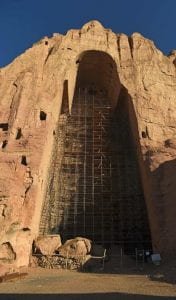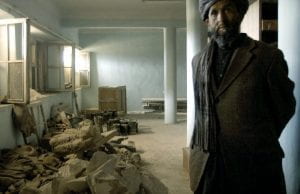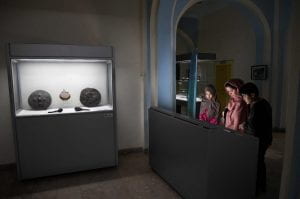While discussing property law theory in one of our classes, Law and Ethics, I remembered the crisis Afghanistan was and is still facing and began to wonder about the state of their antiquities, cultural resources, and museums, under the Taliban’s rule. Little did I know that this had been a subject discussed heavily in the media only a few months ago, so I decided to dig into some past and current events to reveal the status and state of Afghanistan’s cultural history.
After years of conflict and negotiations, in February 2020 the U.S. government and the Taliban signed a peace agreement, which included a timeline by which U.S. troops would withdrawal from Afghanistan. While the U.S. pledged full withdrawal withing 14 months, the Taliban pledged “to prevent territory under its control from being used by terrorist groups and enter into negotiations with the Afghan government.” Unfortunately, with no official cease-fire in place, the Taliban eventually resumed attacks on Afghan civilians, their government, the Afghan National Defense and Security Forces (ANDSF). Despite U.S. air strikes and raids against the Taliban, the Taliban’s violence and suicide attacks allowed them to make territorial gains throughout 2020 and 2021. In April 2021, President Joe Biden announced the removal of U.S. military forces by September 2021 from Afghanistan. The Taliban increased their attacks on urban areas and border crossings, and by mid-August, they had captured all provincial capitals, causing the Afghan President Ashraf Ghani to flee, along with thousands of citizens.

One of the Buddhas of Bamiyan before it was destroyed by Taliban. (Associated Press)
Afghanistan is no stranger to devastation and violence, especially when it comes to their cultural resources. During the Soviet occupation in the 1980s many of their archaeological sites were illegally excavated and looted. 12th century items from the palace of Mas’ud III were looted and sold on the black market in the 1990s during the Afghanistan civil war. In 1992, after the end of communist rule, an estimated 70% of the 100,000 pieces in the National Museum in Kabul’s collection, were looted or damaged. From 1994-2001, the “Dead Sea Scrolls of Buddhism,” some dating to the 2nd century A.D., were stolen and sold to collections around the world. The Taliban destroyed many libraries and museums, persecuted academics, and outlawed art from 1996-2001. Despite the Taliban Minister of Culture claiming in 1999 that Afghanistan’s Buddhist heritage would be protected under his rule, in 2001 the Taliban proceeded to blast with dynamite and artillery the well-known Buddhas of Bamiyan cliff statues, which dated to the 6th century.

The destruction of one of the Buddhas of Bamiyan. (Getty Images)
Today, with Afghanistan once again controlled by the Taliban, and repeated claims that Afghanistan heritage will be safe, the international community is still skeptical. Although there have been statements claiming they have forbidden the selling of antiquities on the black market, instructed fighters to protect and safeguard historical sites, and vowed to stop the looting of archaeological digs, many think the Taliban could easily hold Afghanistan’s cultural heritage hostage in the future. As academics, archaeologists, and curators flee the nation, preservation projects are put on hold, and looting increases, many also question if the artifacts and cultural objects will fall prey to neglect.
Since the destructions in the 1990s and into the 2000s, documentation of Afghan cultural heritage has improved with the creation of museum collection catalogues, archaeological site maps, 3-D models of heritage building, and much more, but the threat of destroying the collections, sites, buildings, and artifacts themselves remains. Although a contingency plan to remove 50,000 of the treasures and move them to safter locations had been created in case of an emergency, the Taliban’s quick takeover prevented this plan from happening.
After being seized by the Taliban in August 2021, the National Museum of Afghanistan reopened late November of the same year, under the protection of Islamic Emirate soldiers. As expected, visitor numbers have dropped, but some hope the reopening is a sign that their Afghan heritage might remain protected and see it as a chance for residents of Kabul, travelers, and younger generations a chance to learn about the history and culture held in the more than 80,000 artifacts contained in the museum. The Taliban have also allowed Mohammad Fahim Rahimi, the director of the museum, the remain in his position. However, some see the reopening as a political move, as music in public areas has still been banded, limitations on radio and television have been put in place, street murals have been painted over, and in Bamiyan just last year the Taliban blew up a statue of the Shitte militia leader Abdul Ali Mazari, whom they killed in 1995. The fundamentalist Taliban are known for their ideological rejection of art that is not considered Islamic or art that portrays living beings. The museum itself contains artifacts, such as their pottery collection, decorated with images of animals and humans, but apparently no changes have been made to restrict what is being displayed. While some also assume the Taliban is trying to project a more “moderate” image, others see reopening as a way to get sanctions lifted and international aid unsuspended.

A museum employee in front of a destroyed statue in the basement of the Kabul Museum in 2001. (AP Photo/Marco Di La Lauro.
The National Museum of Afghanistan is currently open only three days a week, Monday, Wednesday, and Friday, with staff being unpaid and visitors only allowed admission with a permission letter from the Islamic Emirate. The Taliban is also in control of the Mes Aynak, an ancient Buddhist monastery, including the 10,000 artifacts excavated from the site. They control the new museum in the Herat citadel, smaller museums and collections in Kandahar, Ghazni, and Balkh, as well as The Afghanistan National Institute of Music.
Afghanistan is first and foremost facing a humanitarian crisis, as people flee and many who remain sink into poverty. Many cultural heritage staff in Afghanistan and others who have fled, claim to have received threats from the Taliban, as well. When it comes to the safety of the cultural heritage of Afghanistan for now, many can only watch and wait.
Follow IUP Anthropology on Facebook, Twitter, and Instagram
Further Reading:

